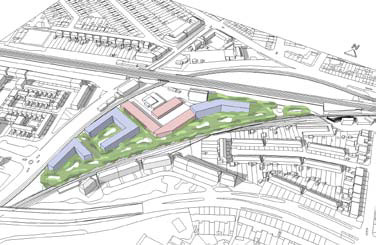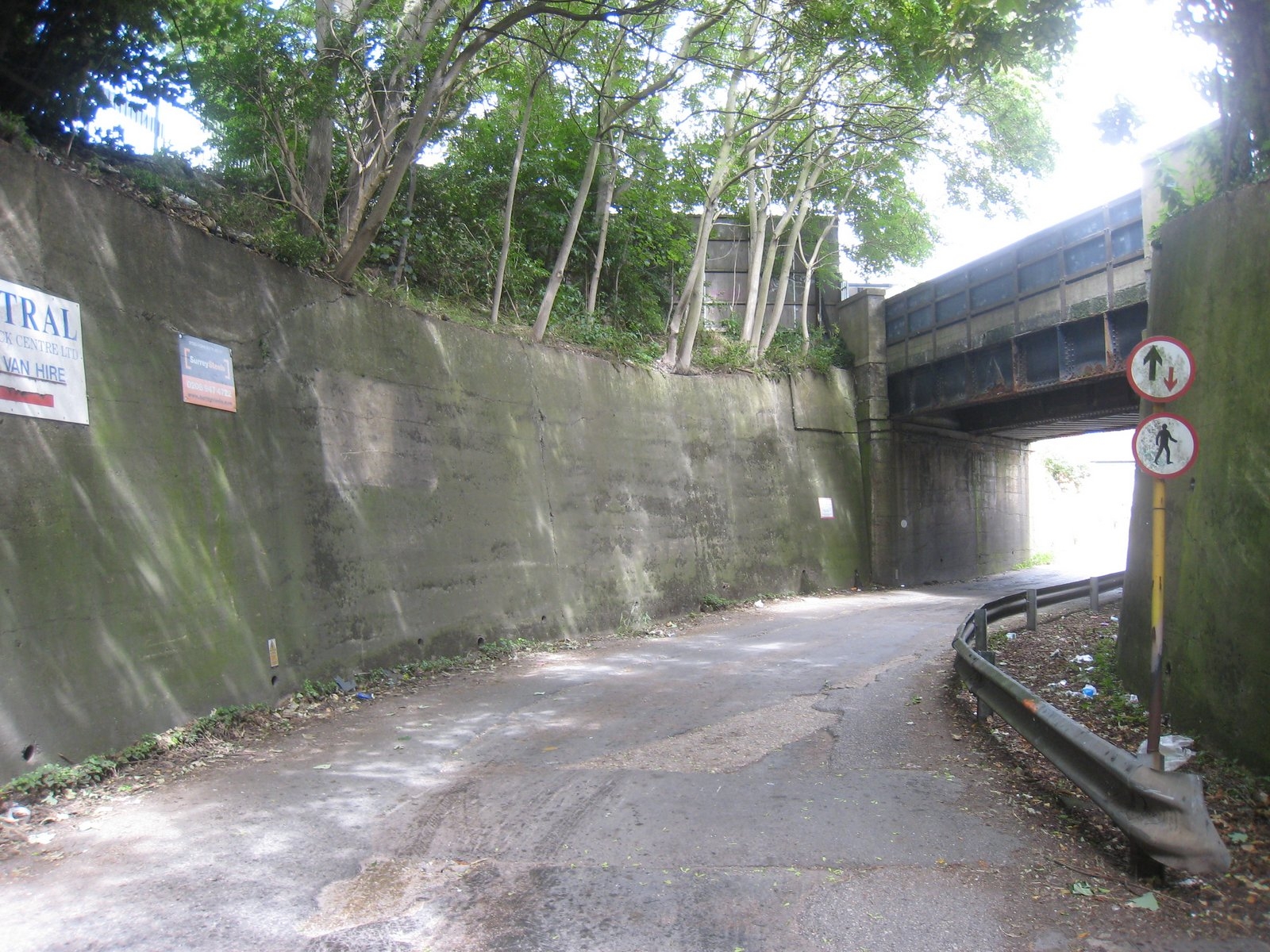Local developments
Rainbow Estate - July 2012
 Merton Council Planning Department has now concluded the formal public consultation phase in relation to the contraversial Planning Brief prepared by the owner of this site on behalf of the Council. However, the Brief can still be downloaded here.
Merton Council Planning Department has now concluded the formal public consultation phase in relation to the contraversial Planning Brief prepared by the owner of this site on behalf of the Council. However, the Brief can still be downloaded here.
The documents may also be viewed at public libraries or a paper copy may be requested by phoning 020 8545 3837 / 020 8545 4141 or via This email address is being protected from spambots. You need JavaScript enabled to view it.
A pubic exhibition of the proposals took place in Raynes Park on 29th &30th June 2012 and a public meeting, called by the Ward Councillors, was held on 10 July 2012. To read about the result of the meeting, click here.
The closing date for submitting comments on the proposals to Merton Planning Dept was 25 July 2012.
WHAT’S ALL THE FUSS ABOUT?
Many of you will know of the existence of this site with its entrance alongside the south side of Raynes Park Station. Most of the land at Rainbow is owned by a company called Workspace Group. Their line of business is normally providing office and small business units across London. In fact, Rainbow is unusual territory for Workspace, in that it is designated by Merton Council in terms of land use as an Industrial Site. Given that there is only one entrance, with no realistic prospect of providing another, and is otherwise totally surrounded by railway lines, this designation is no great surprise.
Although hardly an attractive environment, Rainbow IS important in providing local employment for light industrial use, warehousing and storage, and what Planners call ‘yard-based’ operations. In fact these uses are exactly what are permitted under current planning policy.
 Workspace, however, have different ideas. They are working up proposals to redevelop the greater part of the site with a mix of small business units, offices and residential development. In order to achieve this objective, Workspace needs to have a Planning Brief approved by Merton Council in order to give some credence to a change of use of the site.
Workspace, however, have different ideas. They are working up proposals to redevelop the greater part of the site with a mix of small business units, offices and residential development. In order to achieve this objective, Workspace needs to have a Planning Brief approved by Merton Council in order to give some credence to a change of use of the site.
A Planning Brief is simply a short document written by MERTON COUNCIL’S Planning Officers which is intended to provide guidance to one or more potential developers interested in a particular site. These Briefs – often no more than about 6 to 8 pages – set out what type of development would ‘fit’ the planning guidance; say what the Council would prefer to see developed; explain any constraints e.g. flooding risks; and list the more important and relevant Planning Policies. Armed with this document potential developers can decide whether they want to go ahead with a full Planning Application. It can be seen from this that a Planning Brief can be very useful, but is hardly ever essential whereas with large new schemes a Planning Application is usually a must.
It should be pointed out that in the case of the Rainbow site there would be no need for a Planning Brief at all if the intention was only to intensify employment use of the site for say light industrial purposes or warehousing. For example, the PTS Plumbing Centre has closed and is currently unused. Workspace could try to market this if they were really interested in providing more local employment. In fact there might not be a need for a Planning Application if a new lease was taken up and no external building work was needed. But Workspace Group’s aim is for a total redevelopment, introducing commercial office space and a large number of flats (up to 250). Neither office units nor residential development is an appropriate use of the site at present, which is why a Planning Brief is contemplated. There are about 17 ‘units’ currently operating on the site and our assumption is that a redevelopment would mean the demolition of most if not all the existing buildings with, of course, a large loss of jobs. We have not seen any hard evidence from Workspace that this lost employment would be replaced. In fact it seems more likely there would be a net loss. Incidentally there are two small areas of Rainbow that are outside Workspace’s proposals. These are the areas owned by Network Rail and the old Station Master’s house, which can be seen at the entrance to the site.
So, what is the problem with this draft Planning Brief? Simply that it should be a document written by and fully ‘owned’ by Merton Council. In this instance Workspace drafted the document and the Council Officers reviewed it, and amended it in parts. But we, the public, who are being consulted on this draft, have no way of knowing the precise authorship of its contents. To put it mildly, this is misleading and it is beyond doubt that the draft lacks clarity and transparency. What IS needed is a short conventional draft Brief, written by MERTON COUNCIL STAFF, only for consultation in the normal way. This would set out what the Council feels is suitable redevelopment, and this should include a range of possible alternative uses for the site. These alternatives are totally lacking from the present draft Brief, which gives the impression of bias towards Workspace’s plans.
Workspace Group can, of course, produce whatever publicity material they wish but this should certainly not be presented as a Merton Council Planning Brief.
As indicated earlier, Workspace envisages a wholesale redevelopment on the land they own, and any future development should, under the adopted ‘Planning Guidance’ be “employment led”. Currently the permitted uses of the site include industrial, warehousing and storage (including outdoor storage). What is proposed, however, is to replace the existing industrial buildings with business units containing the equivalent amount of commercial/office space, whilst the current ‘open air’ industrial space would be replaced with a range of one, two and three-bedroom flats up to a total of 250 dwellings. This is despite the fact that strict application of the Planning Guidance does not permit office or residential development on the site. Remember, there is only one vehicle/pedestrian entrance which is not easy to navigate anyway, and the land has three railway tracks surrounding it. Some thought has been given to the possibility of providing an additional access but this would almost certainly be doo difficult or too expensive or both.
Given that Rainbow is a designated Industrial Site providing employment for local people, it would be possible for Workspace to encourage greater employment use, probably without significant up-front costs but instead, it appears, their plans would require terminating the tenancies of the existing users who would probably find it very difficult and expensive to relocate elsewhere. Workspace claim that once their proposals are completed the number of jobs on the site would be double, but there is no hard evidence to support what is probably no more than wishful thinking.
The suspicion cannot be avoided that the real motive behind Workspace’s proposals is the profit anticipated from such a large residential scheme. A range of 200 to 250 flats, some of them ‘family’ units, could mean more than 500 new residents with perhaps a third of those young children with no gardens to play in.
Developers these days are required to make financial contributions towards Government and Council ‘knock-on’ expenditure such as education and health needs, etc. Useful as they are, these payments go nowhere near providing the infrastructure which would be essential to support the large inflow of residents in Raynes Park’s local centre. Just to give one example, it can be seen from the figures provided, that this development would probably spark the need for a new primary school, against a background where people cannot find a place of their choice for their children in local schools at the present time.
Workspace is making a number of claims about how the site would be suitable for new residents, but however ambitious their plans one cannot remove the railway tracks of the station, nor eliminate the considerable noise involved here. Surely this is no place to house people, whatever the need; not forgetting that Raynes Park and West Barnes have made significant contributions to meeting housing targets in recent years.
All large developments these days are supposed to aim for “sustainable development”. No doubt given the demands of modern Building Regulations there would be some sustainability in this scheme, but one must measure ‘sustainable development’ against the definition handed down by the Bruntland Commission at the Rio Earth Summit in 1992. It is difficult to believe that providing new homes on the Rainbow Estate would satisfy that aim in any meaningful way.
David Freeman and Jerry Cuthbert
Other Information
Due to the contraversial manner in which Merton Planning Department has handled this Planning Brief, the Council has issued a statement that you can read here.
The Association's response to the public consultation on the Planning Brief may be read here.
To see Workspace's original submission to the Merton Planning Advisory Committee on the 21 May 2012, click here .
Previous Proposals for the site by Workspace
Previously the Rainbow Estate was being looked at as a possible waste processing area. However, the South London Waste Plan does not consider this as a suitable site for such a facility. To view the South London Waste Plan, click here.